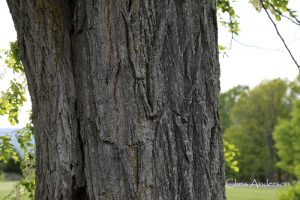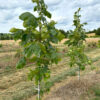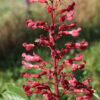 The south boasts some mighty fine natural smells in the spring and summer– honeysuckle, wisteria, lilac, magnolias all in bloom – but the flowers of black locust rank near the top for sweet perfume.
The south boasts some mighty fine natural smells in the spring and summer– honeysuckle, wisteria, lilac, magnolias all in bloom – but the flowers of black locust rank near the top for sweet perfume.
With creamy white panicles resembling wisteria, the flowers of black locust (Robinia pseudoacacia) create a stunning display against the delicate green foliage in early summer. Their fragrance wafts through warm air but admirers only have about ten days to enjoy them as they do not last long.
Ask any farmer what is the best wood for fence posts and many will likely name locust. Indeed, its longevity, even when in contact with soil, is well known and the early Europeans of Jamestown built their first structures using locust. A century later, Mark Catesby, historian and explorer, noted that these original buildings were still standing strong, attesting to locust’s hardiness. Those who heat their homes with wood stoves eagerly seek out locust as an all-nighter wood that burns hot.
As with many native plants, the benefits of locust certainly came from Native Americans. Black locust is native to the Blue Ridge and Appalachian Mountains but Europeans found it growing in the Piedmont and coastal areas when they arrived. Sophisticated and extensive trade routes existed among Native peoples for centuries and it is likely that Shawnee, Cherokee and/or Haudenosaunee shared seeds of black locust with members of the Powhatan Confederacy and other nations to the east. The strength of the black locust wood made it a preferable material not only for building but also for tools, bows and arrow shafts.
Black locust trees now grow around the world as their reputation as a preferred building material, beautiful landscape tree and source of excellent honey spread and seeds and seedlings were exported to other countries.
The scientific name Robinia honors Jean Robin, landscaper and botanist for the King IV of France. Pseudoacacia refers to the leaflets resemblance to the acacia tree.
They belong to the legume family and have alternate, pinnately compound leaves with 7-19 oblong leaflets. The distinctive dark, braided bark resembles thick and fibrous rope with furrows and ridges.
Black locust enjoys full sun and can reach heights averaging 70-80 feet with a diameter of two to three feet. They do not tolerate shade very well. Given plenty of room, they can grow surprisingly attractive and balanced canopies. Their seeds resemble flat pods and rabbits, deer, bobwhite quail, mourning doves and others consume them. Honey connoisseurs seek out the light – sometimes almost clear – honey, made more valuable as some years are much better than others for nectar production. George Petrides and Janet Wehr note in Eastern Trees[1] that young shoots and bark can sometimes be poisonous to livestock.
 In the landscape, black locust is valuable as a pioneer species, coming up quickly in disturbed sites. As with other legumes, they have the ability to fix nitrogen, an important trait in rebuilding soil structure following disturbances such as fire or land clearing. They are also good at preventing erosion, as their hardiness allows them to take hold and grow fast on slopes. They are often used on mine reclamation sites due to their hardy nature and ability to withstand acidic soils.
In the landscape, black locust is valuable as a pioneer species, coming up quickly in disturbed sites. As with other legumes, they have the ability to fix nitrogen, an important trait in rebuilding soil structure following disturbances such as fire or land clearing. They are also good at preventing erosion, as their hardiness allows them to take hold and grow fast on slopes. They are often used on mine reclamation sites due to their hardy nature and ability to withstand acidic soils.
 They are generally not bothered by many pests, though leaf miners can occasionally blemish the foliage. Their tendency for limb die back makes them better suited to larger landscapes away from buildings or parking lots but placed in locations where their fragrant blossoms can be enjoyed and they can spread out unimpeded by other trees.
They are generally not bothered by many pests, though leaf miners can occasionally blemish the foliage. Their tendency for limb die back makes them better suited to larger landscapes away from buildings or parking lots but placed in locations where their fragrant blossoms can be enjoyed and they can spread out unimpeded by other trees.
As noted in the book, The Remarkable Trees of Virginia, in 2007, the Virginia champion black locust graced the yard of a home in Wytheville with a height of 95 feet and a circumference exceeding 168 inches. Its canopy spread shows how beautiful black locust can be in the landscape. The current champion lives in Fauquier County in Upperville with a height of 71 feet, a crown spread of 74 feet and circumference of 195 inches.
As noted in the Remarkable Trees of Virginia2, in 2007, the Virginia champion black locust graced the yard of a home in Wytheville with a height of 95 feet and a circumference exceeding 168 inches. Its canopy spread shows how beautiful black locust can be in the landscape. The current champion lives in Fauquier County in Upperville with a height of 71 feet, a crown spread of 74 feet and circumference of 195 inches.
Chris Anderson, Executive Director
White House Farm Foundation
1917 Kauffmans Mill Rd.
Luray, VA 22835
[1] George Petrides, Janet Wehr, Eastern Trees, (Boston, Houghton Mifflin Co., 1988), p. 230.
[2] Nancy Hugo Ross and Jeff Kirwan, Remarkable Trees of Virginia, (Earlysville, Albemarle Books, 2008), p 115.







